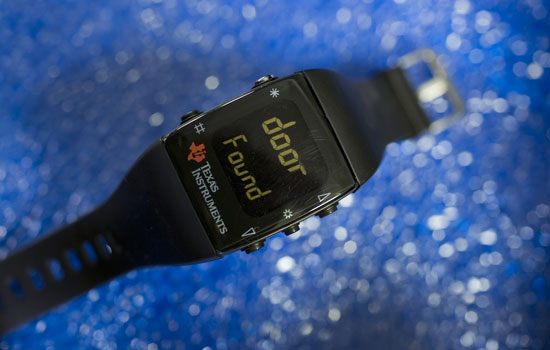Robotics Club Builds Door Lock Using Sports Watch and Wireless Technology
New door lock elements include low power consumption and security features
A. Sue Weisler
Members of the RIT Robotics Club re-fitted a high-end wristwatch to be a wireless door-lock device. The group awaits the outcome of the design competition entered recently.
All they wanted to do was get into their campus apartment, and along the way they became online stars.
Ziyan Zhou and Zachery Shivers, members of the Robotics Club at Rochester Institute of Technology, submitted their wireless door-lock entry to the 2010 Texas Instruments Ultra Low-Power Challenge. Ever since then, a video about the project design has been front-page news on such high tech blog sites as Gizmodo and Hack-a-Day.
“Like many of our Robotics Club projects, we created the wireless door lock for fun in our spare time,” says Zhou, a fifth-year computer science major. He has been in the Robotics Club since 2006 and is the club’s vice-president. He, Shivers and the other members of the club researched different door-lock technologies, such as RFID personal tags, and even secret door knocks as options for the design contest.
The group started on the design and entered the national competition. One of the requirements was to use Texas Instruments’ products, and the team chose the company’s eZ430-Chronos sport development watch. Another requirement was to develop an innovative device that used the lowest possible power.
“The watch communicates wirelessly to the lock and unlocks the door after given a secret password, a sequence of taps on the watch’s three-axis accelerometer,” Zhou explains. “This system demonstrates an ultra-low power consumption wireless system.”
The solution enables individuals to access areas using a keyless entry by requiring two–tier authentication.
“A traditional key is something unique that you have. So is a watch, with a unique, 128-bit encryption key in it that only the door and the watch shares,” he says. “However, in the traditional case, losing the key can be translated into high security risk. In our case, an attacker needs both the watch and your personal knock sequence to unlock the door. So having only the watch is not enough to unlock the door.”
Zhou and Shivers are still waiting for the results from the competition. The video of their project has scored more than 28,000 views on several online sites, including Zhou’s blog. Those interested can vote on the RIT Robotics project, one of 38 entries on the Texas Instruments site. Winners will receive $10,000 in prizes from the company. The project is also entered in the 2010 Imagine RIT: Innovation and Creativity Festival, May 1.
“The online community, especially hackaday.com, gave us many wonderful suggestions and support. Between now and May, we plan to add new features to our existing system, including an audit system that logs entries to the door, a ‘tweet’ publication by the door about its entries, and bunch of other electrical design details that would make the system a viable commercial solution,” Zhou adds.











